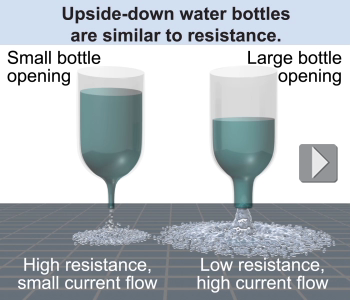|
If you connect a 1.5 V battery across a circuit, how much current will flow through the circuit? It depends on the resistance of the circuit. Resistance is a measure of how easily current can flow through a circuit. Too much resistance permits only a small amount of current to flow. The connection among voltage, current, and resistance is an important part of understanding electric circuits. 
|
Ohm’s law
|
An ordinary lamp plugged into a 120 V receptacle draws a current of about 0.2 A when it is switched on. A hair dryer connected to the same voltage draws a current of 11 A. What property of the lamp and the hair dryer determine how much current they draw? The answer is a fundamental relationship of electricity. 
|
Electrical resistance measures how easily current can flow. At any given voltage, a higher resistance means less current flows. A lower resistance means more current flows. The relationship among current, voltage, and resistance is called Ohm’s law, after the German physicist Georg Simon Ohm, who discovered it. 
|
| (17.1) | | | V | = | voltage or potential difference (V) | | I | = | electric current (A) | | R | = | resistance (Ω) |
| Ohm’s law
|
|
Resistance is measured in ohms. The symbol for an ohm is the Greek capital letter Omega or Ω. One ohm (Ω) is one volt per ampere. A resistance of 1 Ω means 1 A of current will flow when 1 V is applied. The word resistance describes how to think about Ohm’s law. The current I that flows is equal to the applied voltage V divided by the resistance R of the circuit. 
|
 An upside-down water bottle makes a useful analogy for how resistance relates to current. A small opening has a large resistance and therefore only a small current of water dribbles out. A large opening has a low resistance and the current of water is large. Mathematically, resistance is in the denominator of the fraction (under voltage), so an increase in resistance makes the current smaller and a decrease in resistance makes the current larger. Doubling the resistance of a circuit results in only half as much current flowing.
An upside-down water bottle makes a useful analogy for how resistance relates to current. A small opening has a large resistance and therefore only a small current of water dribbles out. A large opening has a low resistance and the current of water is large. Mathematically, resistance is in the denominator of the fraction (under voltage), so an increase in resistance makes the current smaller and a decrease in resistance makes the current larger. Doubling the resistance of a circuit results in only half as much current flowing. 
|
Ohm’s law is not a fundamental law of nature like Newton’s three laws of motion. Instead, it is an observed relationship among voltage, current, and resistance that most materials obey in electric circuits most of the time. Exceptions to Ohm’s law include devices such as transistors and diodes, for which the current flows through tiny structures of different materials with different electrical characteristics. 
 |
The equation I = V/R describes a relationship among the quantities where I is directly proportional to V, while I is inversely proportional to R. The mathematical term directly proportional describes a relationship where doubling one quantity causes the other to double. For example, we can look at a circuit with 1 V of voltage across 1 Ω of resistance causes 1 A of electric current. If we double the voltage to 2 V, while keeping the resistance the same, then the current also doubles to 2 A. I and V are directly proportional because increasing or decreasing one quantity by a factor results in the other quantity increasing or decreasing by the same factor. A directly proportional relationship is described mathematically as | | | Directly proportional relationship
|
In mathematics the term inversely proportional describes the opposite kind of relationship. In the same example, if we were to keep the voltage constant at 1 V but double the resistance to 2 Ω, then the current would be halved to 0.5 A. Doubling the resistance causes the current to be halved. That is an inversely proportional relationship between I and R, which is described mathematically as | | | Inversely proportional relationship
|

|
What battery voltage would you need to send 2.5 A of current through a light bulb with 3.6 Ω of resistance? - 1.2 V
- 1.5 V
- 9 V
- 12 V
 |
The correct answer is c. Use the equation V = IR = (2.5 A) × (3.6 Ω) = 9 V. 
|

